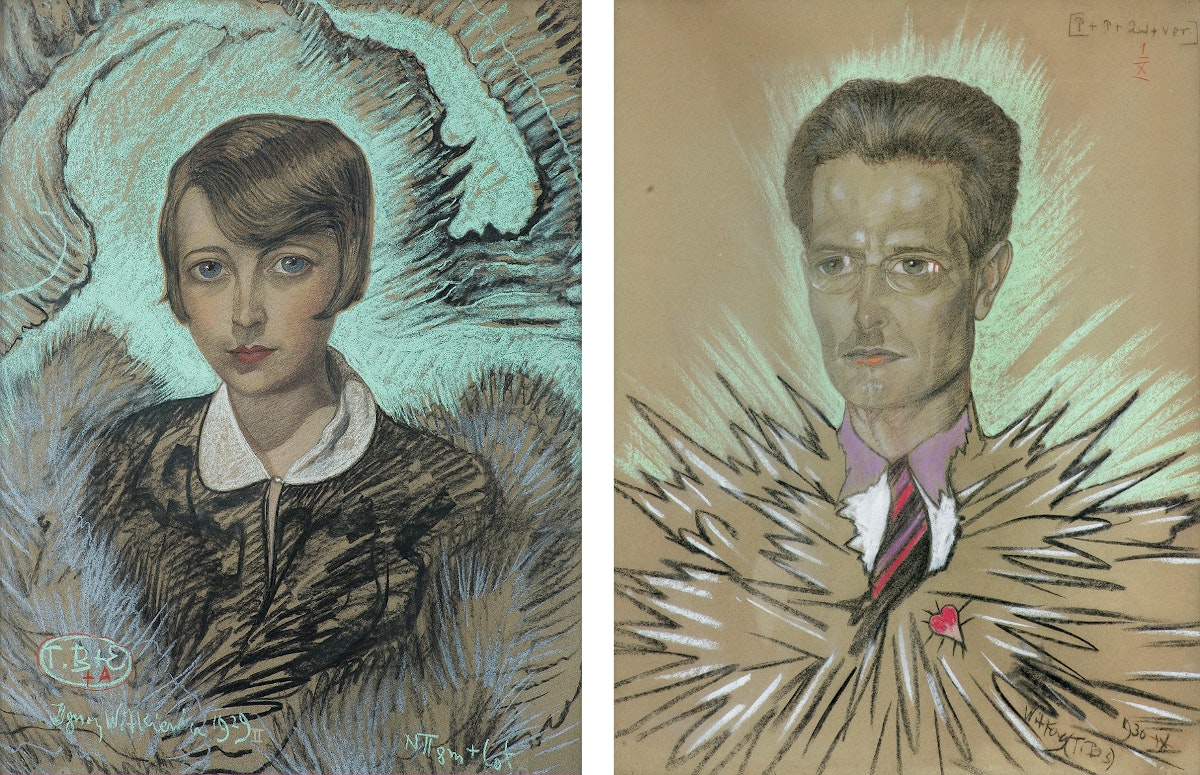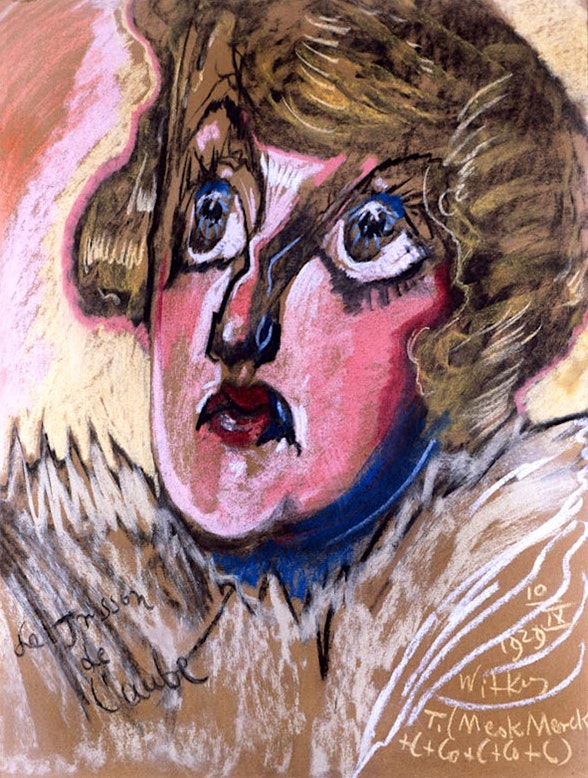
Much of the information in this post comes from Juliette Breton at the Public Domain Review. See her post for more.
At least once a day, staff at art museums and galleries worldwide must hear someone say, “the artist must have been on drugs.” It’s the easiest explanation for art that disturbs, unsettles, confounds our expectations of what art should be. Maybe sometimes artists are on drugs. (R. Crumb tells the story of discovering his inimitable style while on acid.) But maybe it’s not the drugs that make their art seem otherworldly. Maybe mind-altering substances make them more receptive to the source of creativity.…
In any case, artists have long used psychoactive substances to reach higher states of consciousness and cope with a world that doesn’t get their vision. In the early days of LSD experimentation, one psychiatrist even tested the phenomenon. UC Irvine’s Oscar Janiger dosed volunteer subjects at a rented L.A. house, then had them draw or otherwise record their experiences. He ultimately aimed to make a “creativity pill,” testing hundreds of willing subjects between 1954 and 1962.

Had Polish artist Stanisław Ignacy Witkiewicz (1885–1939) — who went by “Witkacy” — lived to see the spread of LSD, he would have signed up for every trial. More likely, he would have conducted his own experiments, with himself as the sole test subject. The Warsaw-born artist, writer, philosopher, novelist, and photographer died in 1939, the year after Swiss chemist Albert Hoffman accidentally synthesized acid. Throughout his career, however, Witkacy experimented with just about every other psychoactive substance, anticipating Janiger by decades with his portraits — painted while… yes… he was on lots of drugs.
Unlike his contemporary Dalí, Witkacy did not claim to be drugs. But he was hardly coy about their use. He made notes on each painting to indicate his state of intoxication. “Under the influence of cocaine, mescaline, alcohol, and other narcotic cocktails,” Juliette Bretan writes at the Public Domain Review, “Witkacy prepared numerous studies of clients and friends for his portrait painting company, founded in the mid-1920s.” The drugs induced “different approaches to colour, technique, and composition. The resulting images are surreal — and occasionally horrific.” Sometimes the drugs in question were limited to caffeine, a daily staple of artists everywhere. He also made portraits while abstaining from other addictive substances like nicotine and alcohol.

At other times, Witkacy’s notes — written in a kind of code — specified more pronounced usage. He made the portrait above, of Nina Starchurska, in 1929 while on “narcotics of a superior grade,” including mescaline synthesized by Merck and “cocaine + caffeine + cocaine + caffeine + cocaine.” Another portrait of Starchurska (below) made in that same year involved some heavy doses of peyote, among other things.
Witkacy’s investigations were literary as well, culminating in a 1932 book of essays called Narcotics: Nicotine, Alcohol, Cocaine, Peyote, Morphone, Ether + Appendices. The book “owes much to the experimental works of other European psychonauts throughout the nineteenth and twentieth centuries.” Invoking the decadent moralism of Thomas De Quincey and Baudelaire, and it anticipates the utopian, psychedelic prose of Aldous Huxley and Carlos Castaneda.

Where he might fulminate, with satirical edge, against the use of drugs, Witkacy also joyously records their liberating effects on his creative consciousness. His chapter on peyote “most closely approximates the spirit” of his paintings, notes Bibiliokept in a review of the recently republished volume:
“Peyote” begins with Witkiewicz taking his first of seven (!) peyote doses at six in the evening and culminating around eight the following morning with “Straggling visions of iridescent wires.” In increments of about 15 minutes, Witkiewicz notes each of his surreal visions. The wild hallucinations are rendered in equally surreal language: “Mundane disumbilicalment on a cone to the barking of flying canine dragons” here, “The birth of a diamond goldfinch” there.
Elsewhere he writes of “elves on a seesaw (Comedic number)” and “a battle of centaurs turned into a battle between fantastical genitalia,” all of which lead him to conclude, “Goya must have known about peyote.”

Narcotics functions as a kind of key to Witkacy’s thinking as he made the portraits; part drug diary, part artistic statement of purpose, it includes a “List of Symbols” to help decode his shorthand. The artist committed suicide in 1939 when the Red Army invaded Poland. Had he lived to connect with the psychedelic revolution to come, perhaps he would have been the artist to make psychotropic drug use a respectable form of fine art. Then we might imagine conversations in galleries going something like this: “Excuse me, was this artist on drugs?” “Why yes, in fact. She took large doses of psylocybin when she made this. It’s right here in her manifesto.….”
See many more Witkacy portraits by visiting Juliette Bretan’s post at the Public Domain Review.
Related Content:
R. Crumb Describes How He Dropped LSD in the 60s & Instantly Discovered His Artistic Style
Take a Trip to the LSD Museum, the Largest Collection of “Blotter Art” in the World
Josh Jones is a writer and musician based in Durham, NC. Follow him at @jdmagness


Well I certainly can relate. I had a niece who lived with me. How I forgot I had a meeting with her teacher? By the time I remembered I had taken a 2 way hit of purple barrel acid. The meeting seemed to go well. Later the teacher told my niece I was one of the nicest most enlightened parents she had met. I have several stories I could relate.
Butt laws got stricter I gave up all drugs to raise my children.
Amazing creative also very inspiring thank you for this article it really cheered me up LSD unlighted my youth l would love to experience peyote buttons I heard it’s an amazing in body experience always wanted to try it
Amazing creative also very inspiring thank you for this article it really cheered me up LSD unlighted my youth l would love to experience peyote buttons I heard it’s an amazing in body experience always wanted to try it
Pretty cool article. Im a little surprised with how loaded this artist could get that there isn’t more expression. And it must have really been a different time to share this kind of thing more openly.
Interesting– I considered painting on LSD in the late 60’s, but decided against it by deciding to reach the state of un/consciousness by natural means. I knew it was somewhere deep inside me or ” far out” and I could find it with meditation, prayer or other ways. Til this day I have not tried Marijuana (didn’t inhale– yes, Bill Clinton,I believed you), LSD, or coke.) And like Jonathan Winters, I sometimes had a difficult time getting back… Maybe its just that I was just plain chicken to try the stuff after reading about the pros and cons… (judgement call). However, my curiosity didn’t prevent me from trying to make acid for a science project (funny story).
Wow I love Witkacy! His paintings the most, I guess, but the books are also fascinating. I’ve read a lot of his works, also the one about drugs. I love his describtions of those crazy visions he had had after peyotl. He was a great artist, one of the best polish ones, but I have a feeling that here, in Poland, he’s underestimated :(
I don’t recommend taking drugs to be “more creative’
You’re either creative or not, having said that I have done in the past but found the work to be unfocused and a bit all over the place. But I guess that’s the idea!
I love vitcacy
Try painting on Salvia Divinorum lol that would be interesting
Have never tried peyote but have used torch cactus which was pretty fun. Anyhow been completely sober for years now which is quite boring. Also if you are looking for a good legal high try Amanita Muscaria those red mushrooms with white dots on the caps they get you absolutely wasted.
Accidentally did x once thought it was a skittle as I was already super drunk and high. Anyhow that is a few days I have very little recollection of. So not know if I have ever tried LSD though would love to do studies with it about altered states of consciousness.
Anyone else done mescaline then thought dark brown looked like red? Just interested.
Do not know not so not know. Eh spell checker messing up my otherwise correct lingo.
Perhaps easily let people know what drugs he was on in what paintings instead of forcing us to be subjected to this unreadable click bait article. Ads consumed, cookies accepted. good work!